Think your best muscle-building years are behind you? Or that you need a pricey gym membership and heavy weights to stay in shape after 40? Science says otherwise.
The truth is that you don’t need fancy equipment or hours at the gym to build muscle. A simple routine using just your body weight can be just as effective as traditional weightlifting. And it only takes three days a week.
This article gives you a clear plan. Seven exercises. Three workouts per week. Real results. The approach is backed by research on muscle growth and protects your joints while giving you maximum gains.
You’ll get detailed instructions for each exercise, a weekly schedule you can start today, and the science behind why this works. No guesswork. Just a proven path to building strength and muscle after 40.
Your complete 12-week muscle-building overview
| Week Range | Focus | Expected Progress | Key Milestone |
|---|---|---|---|
| Weeks 1-2 | Learning form and building habit | Neural adaptations, better mind-muscle connection | Complete all workouts with proper form |
| Weeks 3-4 | Building base strength | 2-3 more reps per set, less soreness | Move to next progression level in 1-2 exercises |
| Weeks 5-8 | Visible muscle development | Clothes fit differently, definition appears | 5-6 more reps per set from week 1 |
| Weeks 9-12 | Strength gains solidify | Measurable size increase, functional strength improves | Complete movements that seemed impossible at start |
Why bodyweight training works after 40
The science of muscle growth at any age
Your muscles don’t have a calendar. They respond to one thing: progressive overload. That means you ask them to do a bit more work over time.
Studies show that progressive bodyweight training creates the same muscle growth as gym-based weightlifting when the intensity matches. Researchers tracked 89 adults aged 35 to 55 for 12 weeks. One group did bodyweight progressions while another lifted weights at a gym. Both groups trained 3 times weekly. The results? Muscle thickness increased by nearly identical amounts—about 5-7% across major muscle groups. The key was training intensity, not the type of resistance.
The key isn’t the equipment. It’s the consistency and intensity you bring to your workouts. When you push your muscles close to failure, they adapt by getting stronger and bigger. This happens whether you’re holding dumbbells or lifting your own body.
Your body can’t tell the difference between 50 pounds of iron and 50 pounds of you. Resistance is resistance.
What the research actually shows
Multiple studies confirm what many fitness pros have known for years: your muscles respond to tension and effort, not to what creates that tension.
A study comparing low-load and moderate-load training found something surprising. Participants doing high-rep bodyweight work gained just as much muscle thickness as those lifting heavier weights. The difference? Training volume and proximity to failure mattered more than load. People who did 25 push-ups to near failure saw similar muscle growth to those who did 8 bench press reps with heavy weights.
Middle-aged adults using bodyweight-only training for 10 weeks showed measurable improvements in muscle endurance and lean mass that matched machine-based training. Some participants gained up to 3 pounds of lean muscle in that timeframe. The study tracked muscle tone, strength, and body composition changes. All three improved significantly.
Research on adults over 40 showed that home-based strength training preserved muscle mass even during caloric restriction. The key factors? Adequate protein intake and consistent training stimulus, not fancy equipment. Participants maintained or even increased lean muscle while losing body fat.
Bodyweight training vs. gym training: the real numbers
| Metric | Bodyweight Training (12 weeks) | Traditional Gym Training (12 weeks) |
|---|---|---|
| Muscle thickness increase | 5-7% | 5-8% |
| Strength gains | 15-25% | 18-28% |
| Time per workout | 30-40 minutes | 45-60 minutes |
| Joint stress level | Low to Moderate | Moderate to High |
| Cost | $0 | $300-$600+ |
| Injury risk | Lower | Higher |
The small difference in strength gains comes from the ability to load heavier with external weights. But for muscle size and functional fitness, the gap is minimal.
Better for your joints, better for your life
Bodyweight exercises offer something weights can’t: built-in safety. You’re not loading your spine or grinding your joints under external weight. The movements are more natural and controlled.
These exercises also build functional strength. You’re training movements you actually use in daily life. Getting up from the floor. Pushing open a heavy door. Carrying groceries. Your body learns to move as one connected unit.
This matters more as you age. Joint health becomes just as important as muscle size. Bodyweight training lets you build both at the same time.
Understanding your exercises: the complete matrix
| Exercise | Primary Muscles | Secondary Muscles | Difficulty Level | Joint Stress |
|---|---|---|---|---|
| Progressive Push-Up | Chest, Triceps | Shoulders, Core | Beginner-Advanced | Low |
| Inverted Row | Back, Biceps | Rear Shoulders, Core | Beginner-Advanced | Low |
| Bodyweight Squat | Quads, Glutes | Hamstrings, Calves, Core | Beginner-Advanced | Low-Moderate |
| Glute Bridge | Glutes, Hamstrings | Lower Back, Core | Beginner-Intermediate | Low |
| Lunge | Quads, Glutes | Hamstrings, Calves, Core | Beginner-Advanced | Moderate |
| Plank | Core (entire) | Shoulders, Glutes | Beginner-Advanced | Low |
| Pike Push-Up | Shoulders | Upper Chest, Triceps, Core | Intermediate-Advanced | Low-Moderate |
This table shows how the exercises complement each other. Notice that every major muscle group gets hit from multiple angles. The core is worked in every single movement, building the stability you need for daily life.
The 7 foundational bodyweight exercises
1. The progressive push-up
Why it’s essential after 40: Builds chest, shoulder, and tricep strength while protecting your shoulder joints. Push-ups teach your body to move as a stable unit from head to toe.
How to do it:
- Place your hands slightly wider than shoulder-width on the floor
- Keep your body in a straight line from head to heels
- Lower your chest until it’s about an inch from the ground
- Press back up, keeping your core tight
- Your elbows should track at about 45 degrees from your body
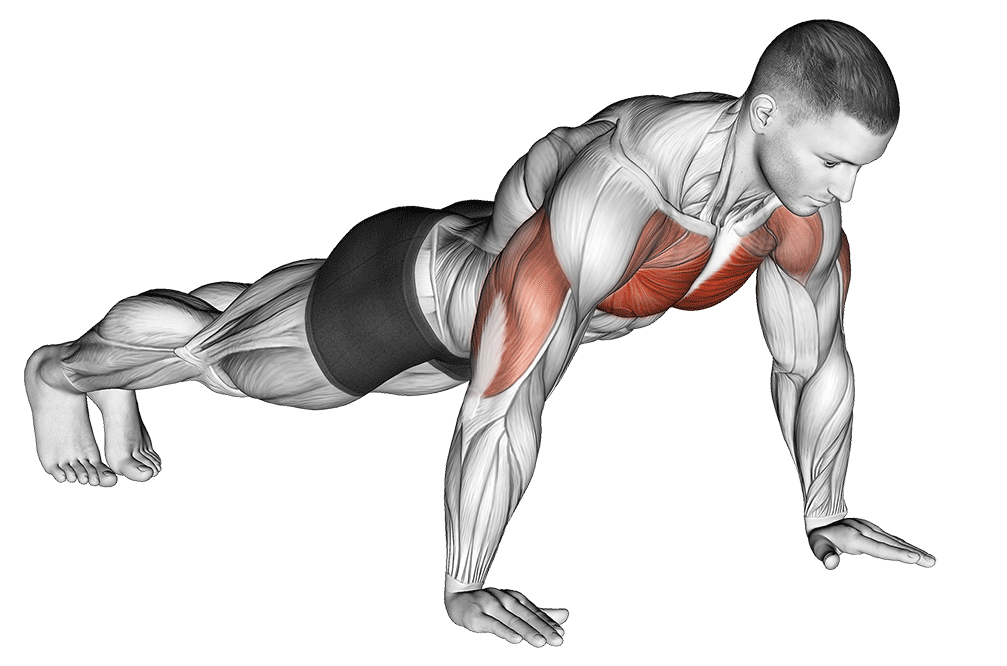
Progressive overload path:
- Beginner: Start with incline push-ups. Place your hands on a sturdy table or bench. The higher the surface, the easier the movement. As you get stronger, move to lower surfaces.
- Intermediate: Standard push-ups from the floor. Focus on form. Aim for 3 sets of 10-15 reps.
- Advanced: Try decline push-ups with your feet elevated. Or add a 2-second pause at the bottom. You can also slow down the lowering phase to 3-4 seconds.
2. The inverted row
Why it’s essential after 40: Builds back and bicep strength. Balances out all the pushing movements. Helps maintain good posture and shoulder health.
How to do it:
- Place a sturdy broomstick across two chairs or use a low table
- Lie underneath with your body straight
- Grab the bar or table edge with hands shoulder-width apart
- Pull your chest up to the bar, keeping your body rigid
- Lower back down with control
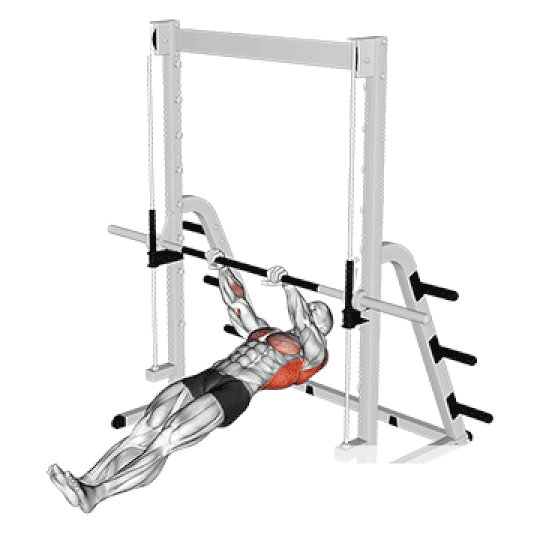
Progressive overload path:
- Beginner: Use a higher surface like a sturdy table. Keep your knees bent with feet flat on the floor.
- Intermediate: Lower the bar height or straighten your legs completely.
- Advanced: Elevate your feet on a chair. Add a pause at the top. Try single-arm rows for a real challenge.
3. The bodyweight squat
Why it’s essential after 40: Builds leg strength and maintains hip mobility. Squats work your quads, glutes, and hamstrings all at once. They’re one of the best exercises for keeping you mobile as you age.
How to do it:
- Stand with feet shoulder-width apart
- Keep your chest up and core engaged
- Lower down as if sitting in a chair
- Go as deep as you can while keeping your heels flat
- Press through your heels to stand back up
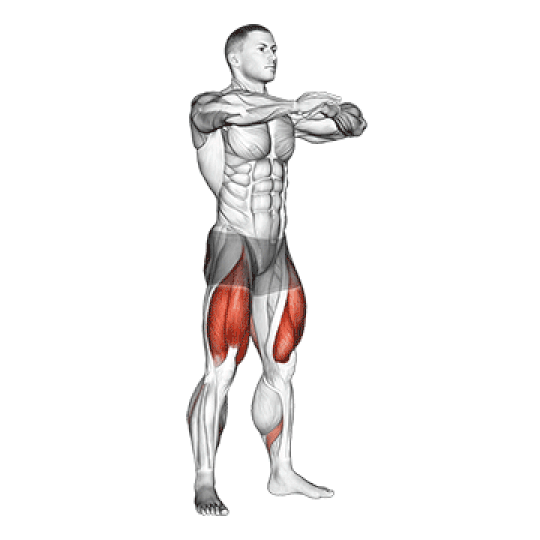
Progressive overload path:
- Beginner: Squat to a chair or bench. Tap it lightly with your butt, then stand back up. This helps you learn the movement pattern.
- Intermediate: Full bodyweight squats with no assistance. Aim for 3 sets of 15-20 reps.
- Advanced: Try pause squats, holding the bottom position for 3 seconds. Or do jump squats for explosive power. Single-leg pistol squats are the ultimate challenge.
4. The glute bridge
Why it’s essential after 40: Strengthens your glutes and hamstrings while protecting your lower back. Many people over 40 have weak glutes from sitting all day. This exercise fixes that problem.
How to do it:
- Lie on your back with knees bent and feet flat on the floor
- Place your feet hip-width apart, about 6 inches from your butt
- Press through your heels and lift your hips up
- Squeeze your glutes hard at the top
- Your body should form a straight line from knees to shoulders
- Lower back down with control
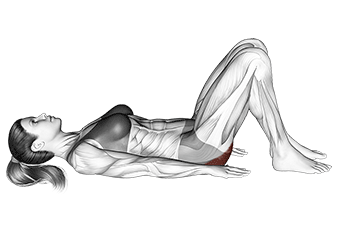
Progressive overload path:
- Beginner: Standard glute bridges. Hold the top position for 2 seconds. Do 3 sets of 15 reps.
- Intermediate: Single-leg glute bridges. Keep one leg extended while you lift.
- Advanced: Elevate your feet on a chair or bench. Add a 5-second hold at the top. Try marching at the top position by lifting one foot at a time.
5. The lunge
Why it’s essential after 40: Builds single-leg strength and balance. Lunges expose and fix imbalances between your left and right sides. They also improve stability and coordination.
How to do it:
- Stand tall with feet hip-width apart
- Step forward with one leg
- Lower your back knee toward the ground
- Keep your front shin vertical
- Your front knee should stay over your ankle
- Push through your front heel to return to standing
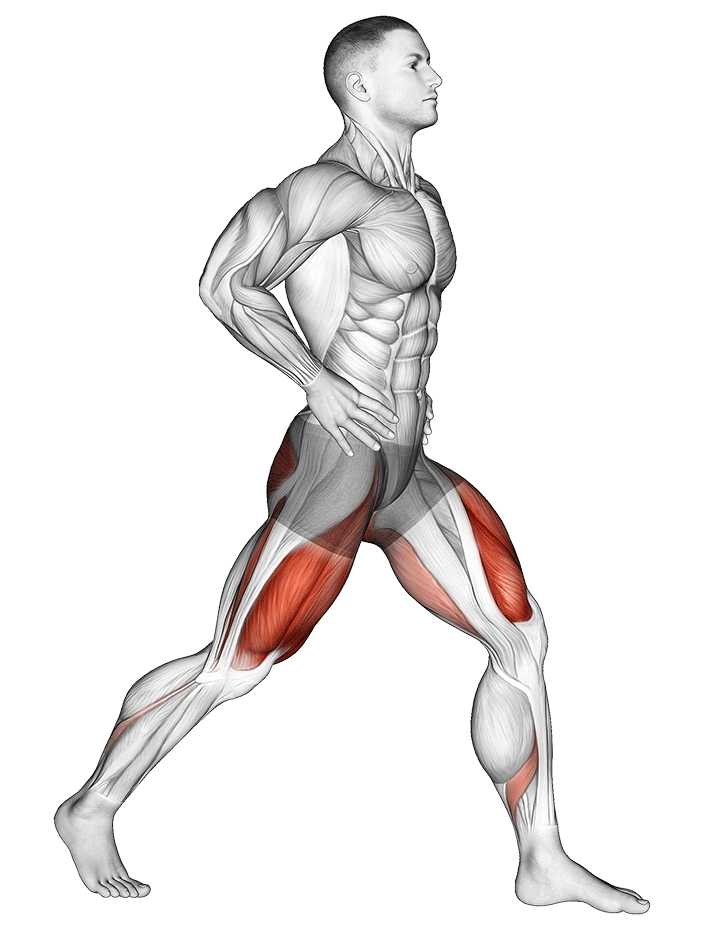
Progressive overload path:
- Beginner: Reverse lunges. Step backward instead of forward. This puts less stress on your knees. Hold onto a wall or chair for balance if needed.
- Intermediate: Forward lunges with no support. Do 3 sets of 10-12 reps per leg.
- Advanced: Walking lunges across your room or yard. Try jumping lunges for explosive power. Add a 3-second pause at the bottom.
6. The plank
Why it’s essential after 40: Builds core stability and strength. A strong core protects your lower back and improves your performance in every other exercise. Planks teach you to keep your whole body rigid under tension.
How to do it:
- Start on your forearms and toes
- Keep your elbows directly under your shoulders
- Your body should form a straight line from head to heels
- Don’t let your hips sag or pike up
- Squeeze your glutes and brace your abs
- Breathe normally while holding the position
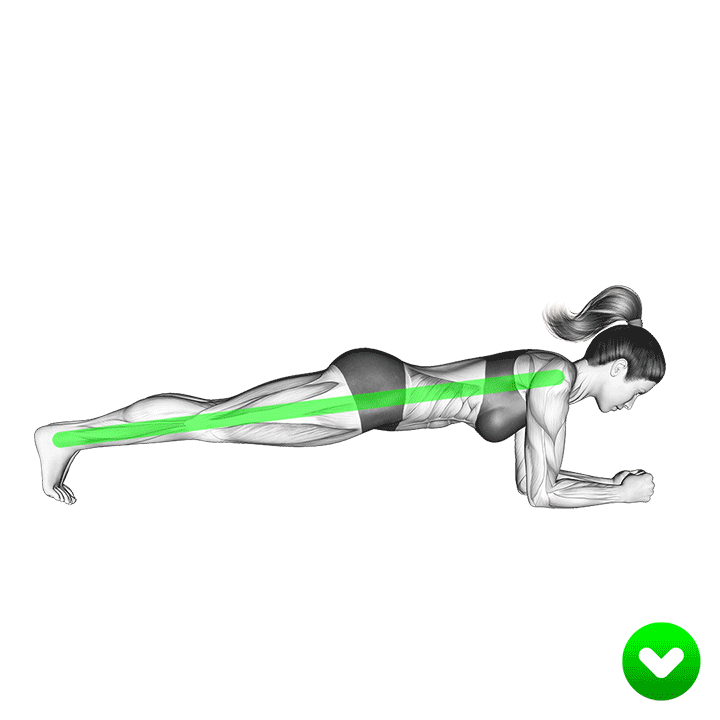
Progressive overload path:
- Beginner: Start with 20-30 second holds. Do 3 sets. You can also do planks from your knees if needed.
- Intermediate: Work up to 60-second holds for 3 sets.
- Advanced: Try side planks for 45 seconds per side. Do plank shoulder taps. Or try a single-leg plank.
7. The pike push-up
Why it’s essential after 40: Targets your shoulders and upper chest. Pike push-ups prepare you for more advanced shoulder work. They build the strength needed to keep your shoulders healthy and mobile.
How to do it:
- Start in a push-up position
- Walk your hands back toward your feet
- Lift your hips high to form an upside-down V shape
- Keep your legs as straight as you can
- Bend your elbows and lower the top of your head toward the ground
- Press back up to the starting position
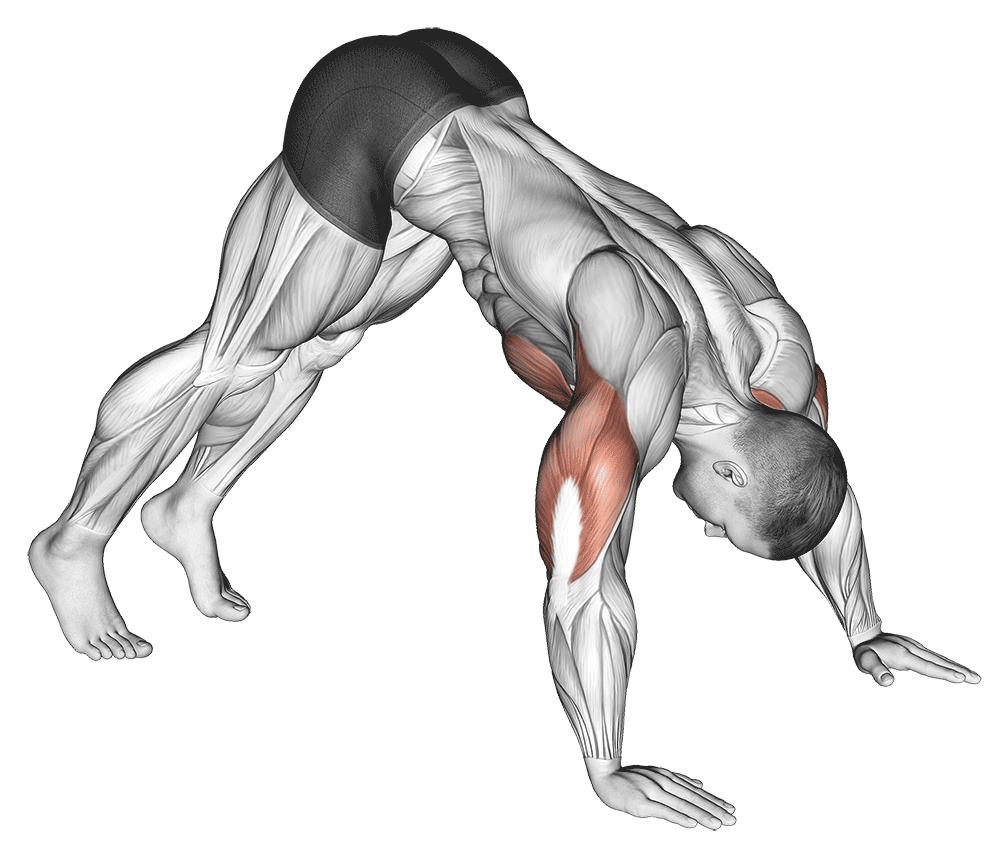
Progressive overload path:
- Beginner: Do pike push-ups with your hands on an elevated surface like a bench. This reduces the amount of body weight you’re lifting.
- Intermediate: Standard pike push-ups from the floor. Aim for 3 sets of 8-12 reps.
- Advanced: Elevate your feet on a chair or bench. This increases the load on your shoulders. Work toward full handstand push-ups against a wall.
Zero-cost equipment solutions for home training
You don’t need to buy anything to make this program work. Here’s how to set up your home gym with items you already own.
For inverted rows:
- Option 1: A sturdy dining table. Lie underneath and pull yourself up to the edge.
- Option 2: A broomstick placed across two chairs of equal height. Make sure the chairs are heavy enough not to tip.
- Option 3: A sturdy countertop or kitchen island. Pull yourself up from underneath.
Safety check: Test any setup by applying weight gradually. If it wobbles or feels unstable, try a different option.
For elevated push-ups:
- Kitchen counter for easiest variation
- Dining table for moderate difficulty
- Sturdy chair or coffee table for harder variation
- Bottom stair step works great too
For decline push-ups:
- Couch or bed (feet elevated)
- Sturdy chair
- Bottom stair step
For elevated glute bridges:
- Couch or bed
- Coffee table
- Sturdy chair
Never use rolling chairs, unstable furniture, or anything that could collapse under your weight. Your safety comes first.
Exercise modifications for common issues
| Issue | Affected Exercises | Recommended Modification |
|---|---|---|
| Shoulder pain | Push-Ups, Pike Push-Ups | Start with incline variations, keep elbows closer to body, reduce range of motion |
| Wrist pain | Push-Ups, Pike Push-Ups, Planks | Use fists instead of flat palms, try forearm plank variation, use push-up handles if available |
| Knee pain | Squats, Lunges | Reduce depth, try box squats, switch to reverse lunges, keep weight in heels |
| Lower back pain | Squats, Glute Bridges, Planks | Focus on core bracing, reduce range, try wall sits instead of squats, shorter plank holds |
| Elbow pain | Push-Ups, Inverted Rows | Keep elbows at 45 degrees (not flared), reduce range of motion, increase rest between sets |
| Balance issues | Lunges, Single-leg work | Hold onto wall or chair, start with split squats (back foot elevated, no stepping) |
| Limited mobility | Squats, Pike Push-Ups | Use elevated surface for hands, reduce range, work on mobility separately on rest days |
If pain persists or gets worse, stop that exercise and talk to a doctor or physical therapist. Some discomfort is normal when starting. Sharp or shooting pain is not.
Your 5-minute pre-workout warm-up
Never skip this. A proper warm-up reduces injury risk and improves performance. Your body needs more time to warm up after 40. Cold muscles and stiff joints don’t respond well to sudden demands.
| Exercise | Reps/Time | Purpose |
|---|---|---|
| Arm Circles | 10 forward, 10 backward | Warms up shoulders and increases blood flow |
| Leg Swings | 10 per leg (front/back and side/side) | Loosens hips and improves range of motion |
| Bodyweight Squats (slow) | 10 reps | Activates leg muscles and lubricates joints |
| Push-Up Position Hold | 20-30 seconds | Activates core and prepares upper body |
| Cat-Cow Stretches | 10 reps | Mobilizes spine and activates core |
| Walking Lunges (easy pace) | 5 per leg | Warms up legs and improves balance |
Do these exercises in order. Move smoothly without jerking or bouncing. You should feel warm but not tired when you finish. If you’re still feeling stiff, do another round of arm circles and leg swings.
On cold days or if you’re extra stiff, add 2-3 minutes of light movement before this warm-up. Walk around your house or march in place.
Your 3-day-a-week muscle-building plan
Here’s your weekly schedule. You’ll alternate between two different workouts, training three days per week with at least one rest day between sessions.
Workout A (Monday and Friday)
- Push-Ups: 3 sets to near failure (leave 1-2 reps in the tank)
- Bodyweight Squats: 3 sets to near failure
- Inverted Rows: 3 sets to near failure
- Plank: 3 sets, hold for 45-60 seconds
Rest 90-120 seconds between sets. This gives your muscles time to recover while keeping your heart rate up.
Workout B (Wednesday)
- Pike Push-Ups: 3 sets to near failure
- Lunges: 3 sets per leg to near failure
- Glute Bridges: 3 sets to near failure
- Plank: 3 sets, hold for 45-60 seconds
Rest 90-120 seconds between sets.
Your weekly schedule at a glance
| Monday | Tuesday | Wednesday | Thursday | Friday | Saturday | Sunday |
|---|---|---|---|---|---|---|
| Workout A + 5-min warm-up | Rest or light walk | Workout B + 5-min warm-up | Rest or light activity | Workout A + 5-min warm-up | Rest or active recovery | Rest or meal prep |
Total training time per week: 90-120 minutes. That’s less than 2 hours to build muscle and strength.
How to progress each week
Here’s the simple rule: add one more rep to each set every week. That’s it.
Let’s say you did 12 push-ups in your first set this week. Next week, aim for 13. When you can comfortably do 20 reps in a set, it’s time to move to the next level of difficulty.
If you’re doing incline push-ups and hitting 20 reps, move to standard push-ups. If you’re doing standard push-ups and hitting 20, try decline push-ups or add a pause at the bottom.
Research supports this approach. A study comparing low-load and moderate-load training found something surprising. Participants doing high-rep bodyweight work gained just as much muscle thickness as those lifting heavier weights. The difference? Training volume and proximity to failure mattered more than load.
The goal is to challenge your muscles. When a set feels easy, you’re not creating enough stimulus for growth. Push close to failure, but always maintain good form.
On Friday, you repeat Monday’s workout. But you’re not just going through the motions. Try to beat your Monday numbers by one rep per set. This constant progression is what builds muscle.
5 mistakes that sabotage your progress (and how to fix them)
Mistake 1: Training to absolute failure every set
Going to complete failure sounds tough and productive. But it’s not optimal for muscle growth. When you train to true failure, you accumulate too much fatigue. This hurts your performance in later sets and increases recovery time.
The fix: Stop each set when you have 1-2 reps left in the tank. You should feel challenged but still able to maintain good form. Save true failure for your last set only.
Mistake 2: Not tracking your progress
Your memory isn’t reliable. If you don’t write down your numbers, you can’t know if you’re actually progressing. You might repeat the same workout for weeks without realizing it.
The fix: Use the progress tracker above. Write down your reps after each workout. This takes 30 seconds and makes a huge difference. You’ll know exactly what to beat next time.
Mistake 3: Inconsistent protein intake
You might eat enough protein on training days but slack off on rest days. Or you might eat most of your protein at dinner and almost none at breakfast. Your muscles need steady protein all week long.
The fix: Hit your protein target every single day, spread across 3-4 meals. Set a reminder on your phone if needed. Make it as non-negotiable as brushing your teeth.
Mistake 4: Skipping warm-ups
You’re busy. The warm-up seems like a waste of time. So you jump straight into your working sets. This is how injuries happen. Cold muscles and stiff joints can’t handle sudden stress.
The fix: Do the 5-minute warm-up every time. No exceptions. It takes less time than treating an injury. Plus, you’ll perform better when your body is ready to work.
Mistake 5: Progressing too quickly
You’re excited and motivated. So you try to add 5 reps every workout or jump to harder variations too fast. Your body can’t adapt that quickly. You end up sore, tired, and potentially injured.
The fix: Add just one rep per set each week. This seems slow but adds up to serious progress over 12 weeks. Trust the process. Slow and steady wins this race.
Fueling your growth: nutrition and recovery after 40
The protein priority: your building block
Your muscles need protein to repair and grow. After 40, your body becomes less efficient at using protein. You need to eat more to get the same results.
Aim for 0.7 to 1 gram of protein per pound of body weight. If you weigh 180 pounds, that’s 125-180 grams of protein daily.
Good sources include chicken, fish, eggs, Greek yogurt, cottage cheese, and beans. Spread your protein across 3-4 meals. Your body can only use so much at once.
Don’t skip protein after your workout. A meal with 25-40 grams of protein within two hours of training helps maximize muscle growth.
Optimal daily protein distribution
| Meal | Timing | Protein Target | Example Foods |
|---|---|---|---|
| Breakfast | Within 1 hour of waking | 30-40g | 3 eggs + Greek yogurt, or protein smoothie |
| Lunch | Midday | 35-45g | Chicken breast, salmon, or lean beef with vegetables |
| Post-Workout | Within 2 hours of training | 25-40g | Protein shake, chicken, or fish |
| Dinner | Evening | 35-45g | Any lean protein source with complex carbs |
If you train in the morning, your post-workout meal can be breakfast. If you train in the evening, your post-workout meal is dinner. Don’t overthink it. Just hit your total daily target.
Quick post-workout smoothie (5 minutes)
Ingredients:
- 1 scoop vanilla protein powder (25g protein)
- 1 banana
- 1 cup frozen berries
- 1 tablespoon almond butter
- 1 cup unsweetened almond milk
- Handful of spinach (optional, you won’t taste it)
- Ice cubes
Instructions: Throw everything in a blender. Blend for 30 seconds. Drink within 2 hours of your workout.
Macros: 380 calories, 35g protein, 42g carbs, 10g fat
Why it works: Fast-digesting protein starts muscle repair immediately. The fruit provides carbs to replenish energy. Almond butter adds healthy fats. This combination stops muscle breakdown and kickstarts growth.
30-minute muscle-building dinner
Garlic herb chicken with sweet potato and broccoli
Ingredients:
- 6 oz chicken breast
- 1 medium sweet potato
- 2 cups broccoli
- 2 cloves garlic, minced
- 1 tablespoon olive oil
- Salt, pepper, dried herbs (thyme, rosemary)
Instructions:
- Preheat oven to 425°F
- Cut sweet potato into cubes. Toss with half the olive oil and seasonings
- Place sweet potato on baking sheet. Bake for 15 minutes
- Season chicken with garlic, remaining oil, and herbs
- Add chicken and broccoli to the baking sheet
- Bake another 15 minutes until chicken reaches 165°F
- Let rest 5 minutes before eating
Macros: 450 calories, 42g protein, 45g carbs, 10g fat
Why it works: Lean protein for muscle repair. Sweet potato provides energy for tomorrow’s workout. Broccoli offers fiber and nutrients. Simple to make and easy to digest.
Make-ahead breakfast option
Overnight protein oats (prep time: 3 minutes)
Ingredients (per serving):
- 1/2 cup rolled oats
- 1 scoop vanilla protein powder
- 1 tablespoon chia seeds
- 1 cup unsweetened almond milk
- 1/2 teaspoon cinnamon
- Berries for topping (add in morning)
Instructions:
- Mix all ingredients except berries in a mason jar
- Shake or stir well
- Put in fridge overnight
- Add berries in the morning and eat cold or warmed
Make 4-5 jars on Sunday for the whole week.
Macros: 320 calories, 30g protein, 38g carbs, 6g fat
Why it works: High protein breakfast sets you up for muscle growth all day. Oats provide sustained energy. Chia seeds add fiber and omega-3s. Takes zero time in the morning when you’re rushed.
High-protein snack ideas
When you need to hit your protein target but aren’t hungry for a full meal:
- 1 cup low-fat cottage cheese with berries (25g protein, 180 calories)
- 2 hard-boiled eggs with an apple (12g protein, 220 calories)
- Greek yogurt (plain, not flavored) with honey (15-20g protein, 150 calories)
- Protein shake with water (20-25g protein, 110 calories)
- 2 oz turkey jerky (16g protein, 100 calories)
- 1/4 cup almonds with string cheese (16g protein, 300 calories)
Calculating your caloric needs
To build muscle after 40, you need to eat enough. Too few calories and your body won’t build new tissue. Too many and you’ll gain unnecessary fat.
| Activity Level | Description | Multiply Your Body Weight By |
|---|---|---|
| Sedentary | Just this program, desk job | 14-15 |
| Lightly Active | This program + walking 3-4 days/week | 15-16 |
| Moderately Active | This program + other sports or active job | 16-17 |
| Very Active | This program + intense cardio or physical labor | 17-18 |
Example: You weigh 180 pounds and have a desk job but do this program faithfully. That’s lightly active: 180 x 15 = 2,700 calories daily for maintenance.
To build muscle: Add 200-300 calories to your maintenance number. For this example: 2,900-3,000 calories daily.
To lose fat while maintaining muscle: Subtract 300-500 calories from maintenance. For this example: 2,200-2,400 calories daily. Keep protein at 0.8-1g per pound even in a deficit.
Track your weight weekly. If you’re trying to build and not gaining 0.5-1 pound per month, add 200 more calories. If you’re trying to lose and not dropping 1-2 pounds per month, subtract 200 calories.
Hydration: the forgotten muscle builder
Water doesn’t build muscle directly. But dehydration kills performance and slows recovery. Your muscles are about 75% water. When you’re dehydrated, they can’t function properly.
Daily water intake formula:
- Body weight in pounds ÷ 2 = ounces of water per day minimum
- Add 16-20 oz for each hour of training
- Add more if you live in a hot climate or sweat heavily
Example: You weigh 180 pounds. That’s 90 oz (about 11 cups) per day. On training days, drink 106-110 oz total.
Signs you’re drinking enough:
- Urine is pale yellow, not dark
- You rarely feel thirsty
- Energy stays steady through the day
- Recovery between workouts feels good
Signs you need more water:
- Dark yellow urine
- Headaches after training
- Constant fatigue
- Muscle cramps
- Dizziness when standing quickly
Keep a water bottle with you all day. Drink consistently rather than chugging a bunch at once. Your body absorbs water better when you sip throughout the day.
Sleep: when your muscles actually grow
You don’t build muscle in the gym. You build it while you sleep. Your body repairs damaged muscle fibers and makes them stronger during deep sleep.
Aim for 7-9 hours per night. Quality matters as much as quantity. Keep your room cool and dark. Avoid screens for an hour before bed.
If you’re training hard but not sleeping enough, you’re wasting your effort. Sleep is not optional if you want results.
Sleep optimization tips:
- Go to bed at the same time every night
- Keep your bedroom between 65-68°F
- Use blackout curtains or an eye mask
- No caffeine after 2 PM
- Avoid large meals within 2 hours of bedtime
- Try reading instead of scrolling your phone
Research shows that getting less than 6 hours of sleep can reduce muscle protein synthesis by up to 18%. That means your muscles can’t repair and grow properly. One bad night won’t ruin you. But chronic poor sleep will stop your progress.
Are your muscles recovering? Check these signs
| Sign | Well Recovered | Under-Recovered | Action to Take |
|---|---|---|---|
| Energy level | Feel ready to train, energized | Dragging, need extra coffee | Take an extra rest day, check sleep |
| Soreness | Mild or gone by next workout | Still very sore after 48-72 hours | Add a rest day, reduce volume slightly |
| Performance | Matching or beating previous numbers | Can’t hit previous rep counts | Take 2-3 extra rest days, eat more |
| Mood | Positive, motivated | Irritable, dreading workouts | Check stress levels, consider deload week |
| Sleep quality | Falling asleep easily, staying asleep | Trouble falling asleep, waking often | Review sleep hygiene, reduce stress |
| Resting heart rate | Normal (check in morning) | 5+ beats higher than normal | Extra rest needed, possible overtraining |
| Appetite | Normal, healthy hunger | Either no appetite or ravenous all day | Adjust calories, check recovery |
Check these signs weekly. Your body is smart and will tell you what it needs. Listen to it.
Active recovery: keep moving on rest days
Rest days don’t mean sitting on the couch all day. Light movement actually helps recovery by increasing blood flow to your muscles.
Good active recovery options:
- 20-30 minute easy walk
- Light swimming or water aerobics
- Gentle yoga or stretching routine
- Casual bike ride (not intense)
- Playing with kids or grandkids
- Light household chores like gardening
What to avoid on rest days:
- Intense cardio or running
- Additional strength training
- Sports that involve jumping or sprinting
- Anything that leaves you breathing hard
The goal is movement without stress. You should feel refreshed after active recovery, not tired.
Supporting your hormones naturally
After 40, your testosterone and growth hormone levels start to decline. You can’t stop this completely. But you can slow it down and optimize what you have.
How resistance training helps your hormones:
Studies show that resistance training boosts both testosterone and growth hormone production. The effect is temporary but meaningful. Each workout creates a small spike in these muscle-building hormones.
The best part? Bodyweight training produces similar hormonal responses to heavy weightlifting. The key is training intensity, not load. When you push close to failure, your body releases growth hormone and testosterone regardless of what creates the resistance.
One study on middle-aged adults found that consistent resistance training three times per week maintained testosterone levels that would otherwise decline. The control group who didn’t train saw a 1-2% annual decrease. The training group maintained stable levels.
Foods that support hormone health:
| Food Type | Examples | Why They Help |
|---|---|---|
| Healthy fats | Olive oil, avocados, nuts, fatty fish | Support testosterone production |
| Cruciferous vegetables | Broccoli, cauliflower, Brussels sprouts | Help balance estrogen levels |
| Zinc-rich foods | Oysters, beef, pumpkin seeds | Essential for testosterone production |
| Vitamin D sources | Fatty fish, egg yolks, fortified milk | Linked to higher testosterone levels |
| Magnesium foods | Spinach, almonds, black beans | Supports sleep and hormone balance |
What hurts your hormones:
- Chronic stress and high cortisol
- Getting less than 6 hours of sleep
- Extreme calorie restriction or crash dieting
- Excessive alcohol consumption
- Training too much without adequate recovery
- High sugar intake and processed foods
You don’t need supplements or special hormone treatments. Just train consistently, eat well, sleep enough, and manage stress. That’s the foundation.
Your first 30 days: a complete roadmap
The first month is about building the habit and learning the movements. Don’t worry about being perfect. Worry about showing up.
Week 1: Foundation phase
Day 1 (Monday):
- Read through all exercise descriptions
- Do the 5-minute warm-up slowly, focusing on form
- Test each exercise to find your starting level
- Do Workout A, but only 2 sets of each exercise
- Record your numbers in the progress tracker
- Note: You’ll probably feel fine today
Day 2 (Tuesday):
- Rest day
- Drink plenty of water
- Hit your protein target
- Do a 15-minute easy walk if you feel good
- Expect some soreness to start appearing
Day 3 (Wednesday):
- You’ll probably be sore. That’s normal and will decrease each week
- Do the warm-up extra carefully
- Complete Workout B with 2 sets only
- The movement will help reduce soreness
- Track your numbers
Day 4 (Thursday):
- Rest and active recovery
- Go for a light walk
- Stretch gently if you’re still sore
- Focus on protein and hydration
Day 5 (Friday):
- Soreness should be decreasing
- Do Workout A again with full 3 sets this time
- Try to match or beat Monday’s numbers
- Notice how the movements feel more natural
Days 6-7 (Weekend):
- Complete rest or very light activity
- Meal prep for the coming week
- Prepare your workout space if training at home
- Review your progress tracker
Week 2: Building consistency
This week’s goal: Complete all three workouts with proper form. Add 1 rep to at least one exercise.
- Monday: Workout A (3 sets)
- Tuesday: Rest
- Wednesday: Workout B (3 sets)
- Thursday: Rest
- Friday: Workout A (3 sets)
- Weekend: Rest and prep
You should feel less sore this week. The movements should feel more familiar. Don’t increase difficulty yet. Focus on adding reps within your current progression level.
Week 3: First adaptations
This week’s goal: You should notice the exercises feeling easier. This is neural adaptation—your brain is learning to recruit muscle fibers more efficiently.
Continue the same schedule. By Friday, you should be able to add 2-3 reps to most exercises compared to Week 1. If an exercise reaches 20 reps, consider moving to the next progression level next week.
Week 4: Assessment and adjustment
This week’s goal: Complete all workouts and assess your progress.
At the end of this week, compare your numbers to Week 1. You should see:
- 3-6 more reps per exercise
- Less soreness after workouts
- Better form and control
- More energy overall
If you’ve hit 20 reps in any exercise, move to the next progression level starting Week 5.
If you’re struggling to add reps, check these factors:
- Are you eating enough protein?
- Are you sleeping 7-9 hours?
- Are you too stressed?
- Did you progress too quickly?
Adjust as needed. Some exercises will progress faster than others. That’s normal.
What to expect: your 12-week transformation
Weeks 1-2: The adaptation phase
What’s happening in your body: Your nervous system is learning new movement patterns. Your brain is figuring out which muscles to activate and when. This is called neuromuscular adaptation.
What you’ll notice:
- Significant soreness after your first few workouts
- Exercises feel awkward or uncoordinated
- You might feel frustrated with low rep counts
- Energy levels may dip slightly as your body adjusts
What you won’t notice yet:
- Visible muscle growth
- Significant strength gains
- Changes in how clothes fit
Key focus: Nail down proper form. Show up for all three workouts. Hit your protein target daily.
Weeks 3-4: Neural improvements
What’s happening in your body: Your nervous system is getting more efficient. You’re recruiting more muscle fibers with each rep. This is why exercises suddenly feel easier even though your muscles haven’t grown much yet.
What you’ll notice:
- Exercises feel more natural and controlled
- You can do 2-3 more reps than Week 1
- Soreness decreases significantly
- Better mind-muscle connection
- More energy during workouts
What you won’t notice yet:
- Obvious muscle size increases
- Major body composition changes
Key focus: Start pushing closer to failure. Add one rep every week consistently. Consider moving to harder progressions if you’re hitting 20 reps.
Weeks 5-8: Visible muscle development begins
What’s happening in your body: Actual muscle growth (hypertrophy) is starting. Your muscle fibers are getting thicker. Protein synthesis is ramping up. This is when your hard work becomes visible.
What you’ll notice:
- Shirts feel tighter in the chest and shoulders
- Arms look fuller, especially after workouts
- Definition starts appearing in your legs
- You can see your muscles working during exercises
- Friends or family might comment on changes
- Scale weight might increase by 2-4 pounds
What you might not notice: You see yourself daily, so changes seem gradual. Take progress photos at Week 8 and compare to Week 1. The difference will surprise you.
Key focus: Stay consistent. Don’t change the program. Keep protein high. Sleep well. Trust the process.
Weeks 9-12: Strength gains solidify
What’s happening in your body: Muscle growth continues. Your strength is increasing substantially. Your body is more efficient at everything—recovery, protein synthesis, energy usage.
What you’ll notice:
- You’re doing exercises that seemed impossible in Week 1
- Regular clothes might fit differently
- Better posture without thinking about it
- Daily tasks feel easier (carrying groceries, climbing stairs)
- More stable energy throughout the day
- Confidence in your physical abilities
Measurable changes by Week 12:
- 5-8 more reps per exercise compared to Week 1
- 2-5 pounds of lean muscle gain (or maintained muscle while losing fat)
- 15-25% strength increase across all movements
- Waist might shrink even if weight stays the same
Key focus: Plan your next 12 weeks. Decide if you’ll continue the program, increase difficulty, or try new variations.
Troubleshooting: when progress stalls
Identifying a true plateau
Not all stalls are plateaus. Your progress won’t be perfectly linear. Some weeks you’ll add reps easily. Other weeks you might stay the same.
A true plateau is:
- No progress for 3+ consecutive weeks
- Same rep counts across multiple workouts
- No change in how exercises feel
- Despite good sleep, nutrition, and recovery
Not a plateau:
- One bad workout (could be stress, poor sleep, or just an off day)
- Staying at the same reps for one week
- Feeling tired or weak occasionally
If you’ve had two bad workouts in a row, check your recovery markers in the table above. You might just need extra rest.
Four strategies to break through plateaus
Strategy 1: Take a deload week
After 8-10 weeks of consistent training, your body might need a break. A deload reduces volume to let your body fully recover and adapt.
For one week:
- Do only 2 sets of each exercise instead of 3
- Stop 3-4 reps short of failure instead of 1-2
- Keep the same exercises and schedule
The next week, return to normal training. You’ll often break through your plateau immediately.
Strategy 2: Adjust your rep ranges
If you’ve been stuck at 15 reps on an exercise for weeks, try this:
- Move to the next harder progression
- You’ll drop to 8-10 reps
- Build back up to 20 reps at this new level
This provides a fresh stimulus for growth.
Strategy 3: Change your rest periods
Been resting 90 seconds between sets? Try 120 seconds for two weeks. The extra recovery might let you squeeze out more reps.
Or go the other way—drop to 60-75 seconds for a conditioning effect. This won’t build as much strength but can shock your body into adapting.
Strategy 4: Increase training frequency
If an exercise is really stuck, try adding one extra set per week:
- On a rest day, do 2 sets of just that exercise
- Keep intensity moderate (leave 3-4 reps in the tank)
- Do this for 2-3 weeks, then return to normal schedule
Don’t do this for multiple exercises at once. Pick one stubborn movement.
When to deload
Plan a deload week every 8-10 weeks even if you’re not stalled. Think of it as routine maintenance. Your body accumulates fatigue over time that normal rest days can’t fully clear.
Signs you need an unplanned deload:
- Consistently low energy for 2+ weeks
- Motivation is dropping
- Sleep quality decreases
- Minor aches that won’t go away
- Resting heart rate is elevated for multiple days
- Every workout feels like a grind
Take the deload week. You won’t lose progress. In fact, you’ll often come back stronger than before.
Measuring your progress beyond the scale
The scale only tells part of the story. After 40, your goal should be muscle gain and fat loss happening simultaneously. The scale might not move much, but your body composition is changing.
Body measurements to track
Take these measurements every 4 weeks. Do them in the morning, before eating or drinking.
Where to measure:
- Chest: Across the fullest part, usually at nipple level
- Shoulders: Around the widest part with arms relaxed
- Arms: Around the fullest part of your bicep, flexed
- Waist: Around your belly button, not sucking in
- Hips: Around the widest part of your butt
- Thighs: Around the fullest part, usually mid-thigh
What changes mean:
| Change | What It Means |
|---|---|
| Chest, shoulders, arms increasing | Building upper body muscle |
| Thighs increasing | Building leg muscle |
| Waist decreasing while others increase | Losing fat while gaining muscle (ideal) |
| Everything increasing slightly | Gaining muscle and some fat (normal in a surplus) |
| Waist decreasing, others staying the same | Losing fat, maintaining muscle |
Don’t obsess over weekly changes. Look at the 4-week and 8-week trends.
Progress photos: your best tool
Photos don’t lie. They show changes you can’t see in the mirror.
How to take good progress photos:
- Same spot, same time of day (morning is best)
- Same lighting (natural light near a window works well)
- Same outfit (underwear or fitted clothes)
- Three angles: front, side, back
- Relaxed and flexed versions
- Take them every 4 weeks
What to look for:
- Muscle definition increasing
- Waistline getting cleaner
- Shoulders looking wider
- Legs showing more shape
- Posture improving naturally
Most people who quit programs would continue if they looked at their progress photos. The changes are there. You just can’t see them daily.
Strength benchmarks
Track these performance markers. They’re objective measures of progress.
After 12 weeks, aim to achieve:
| Exercise | Beginner Goal | Intermediate Goal | Advanced Goal |
|---|---|---|---|
| Push-Ups | 15 standard reps | 25 standard reps | 15 decline reps |
| Inverted Rows | 12 reps (feet down) | 15 reps (feet elevated) | 10 single-arm reps per side |
| Bodyweight Squats | 20 reps full depth | 30 reps full depth | 10 pistol squats per leg |
| Glute Bridges | 20 reps double-leg | 15 reps single-leg | 20 reps feet elevated |
| Lunges | 12 reps per leg | 20 reps per leg | 15 walking lunges with pause |
| Plank | 60 seconds | 90 seconds | 60 seconds single-leg |
| Pike Push-Ups | 10 reps | 15 reps | 12 reps feet elevated |
Where you start depends on your current fitness level. These goals are achievable for most people with consistent training.
Body composition changes
You might gain 2-5 pounds of muscle in 12 weeks while losing 3-8 pounds of fat. The scale might only show 1-3 pounds of change. But you’ll look and feel completely different.
How to tell you’re building muscle and losing fat:
- Strength is increasing consistently
- Clothes fit differently (tighter in chest/shoulders, looser in waist)
- You look better in photos even if weight is the same
- You feel firmer, more solid
- People comment that you look leaner or more fit
This is the holy grail of body transformation. Don’t let the scale discourage you.
Comparing training methods: making an informed choice
You have options. Here’s how this program stacks up against alternatives.
| Method | Time Per Week | Annual Cost | Equipment Needed | Results Timeline | Joint Stress | Travel-Friendly |
|---|---|---|---|---|---|---|
| This Bodyweight Program | 90-120 min | $0 | None | Visible by week 5-8 | Low | Yes |
| Gym Membership | 180-240 min | $300-$600 | Full gym access | Visible by week 5-8 | Medium-High | No |
| Home Gym Setup | 120-180 min | $500-$2000 | Weights, rack, bench | Visible by week 5-8 | Medium-High | No |
| Resistance Bands | 90-120 min | $30-$100 | Bands and handles | Visible by week 6-10 | Low | Yes |
| Minimal Equipment (kettlebell, pull-up bar) | 120-150 min | $100-$300 | 1-2 pieces | Visible by week 5-8 | Low-Medium | Somewhat |
The verdict:
For muscle building after 40, bodyweight training offers the best combination of effectiveness, convenience, and joint safety. You get similar results to gym training with zero cost and maximum flexibility.
The gym might give you 10-15% faster strength gains in the long term because you can add weight indefinitely. But for the first 6-12 months, and for maintaining muscle and function as you age, bodyweight training is equally effective.
The science behind this program
Here’s a summary of the key research that supports this approach.
Study 1: Bodyweight training matches gym results
Source: Journal of Strength & Conditioning Research (2021)
What they did: Researchers tracked 89 adults aged 35-55 for 12 weeks. One group did progressive bodyweight exercises (push-ups, squats, dips) three times weekly. The other group did traditional gym-based resistance training with similar exercises.
Key findings:
- Muscle thickness increased 5-7% in both groups
- No significant difference in hypertrophy between groups
- Strength gains were slightly higher in the weight training group (about 18% vs 28%)
- But muscle size gains were nearly identical
What it means for you: You can build just as much muscle with bodyweight training as you can in a gym. The strength difference is real but small, and mostly matters for specific lifts rather than functional strength.
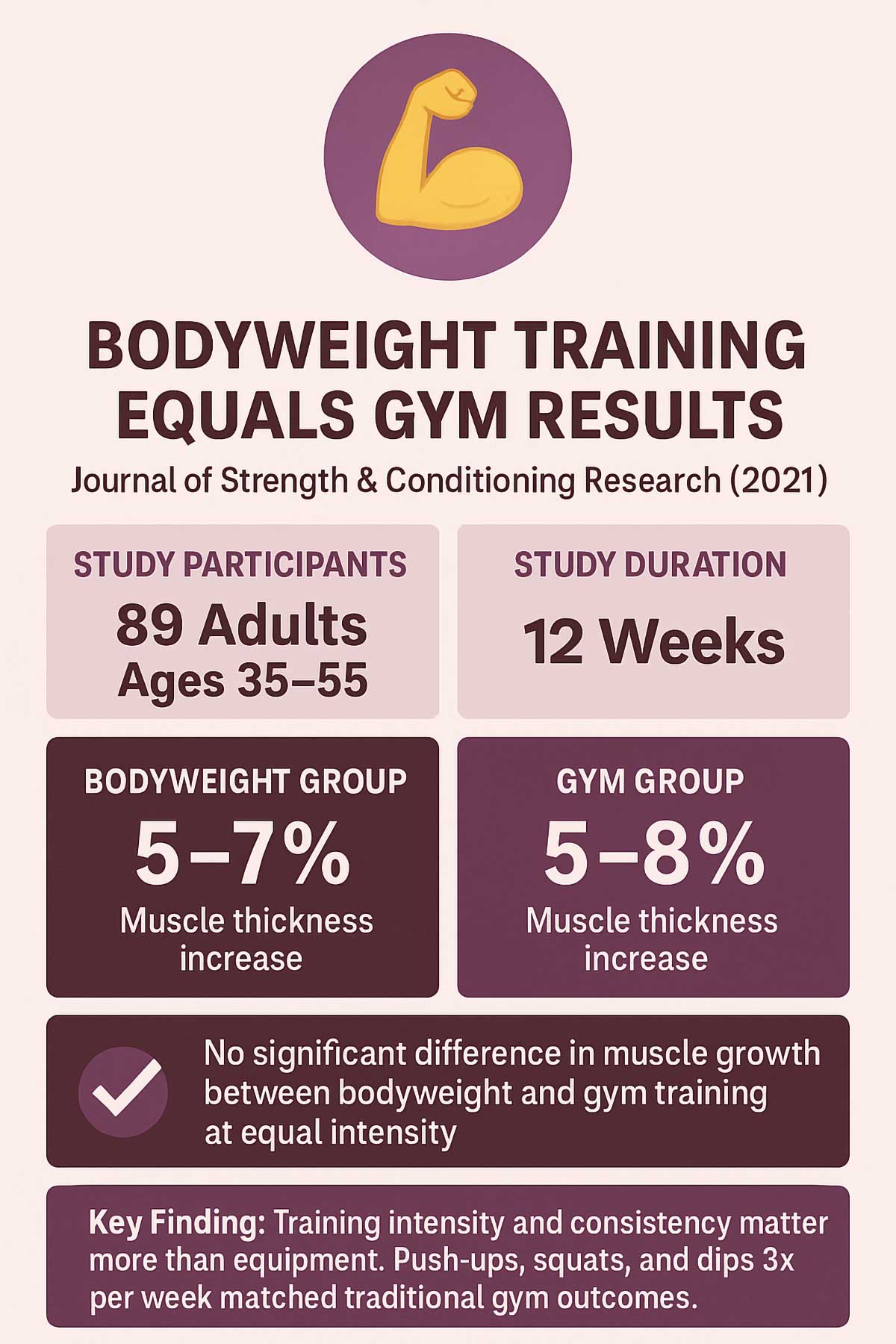
Study 2: High reps build muscle too
Source: European Journal of Applied Physiology (2018)
What they did: Compared low-load resistance training (bodyweight and bands, 20-25 reps) to moderate-load weight training (8-12 reps) over 12 weeks.
Key findings:
- Both groups gained similar muscle thickness
- Both groups gained similar strength
- The high-rep group actually showed better muscle endurance
- Key factor was training to or near failure, not the specific load
What it means for you: Don’t worry that 15-20 reps is “too light” for muscle building. As long as you push close to failure, your muscles will grow.
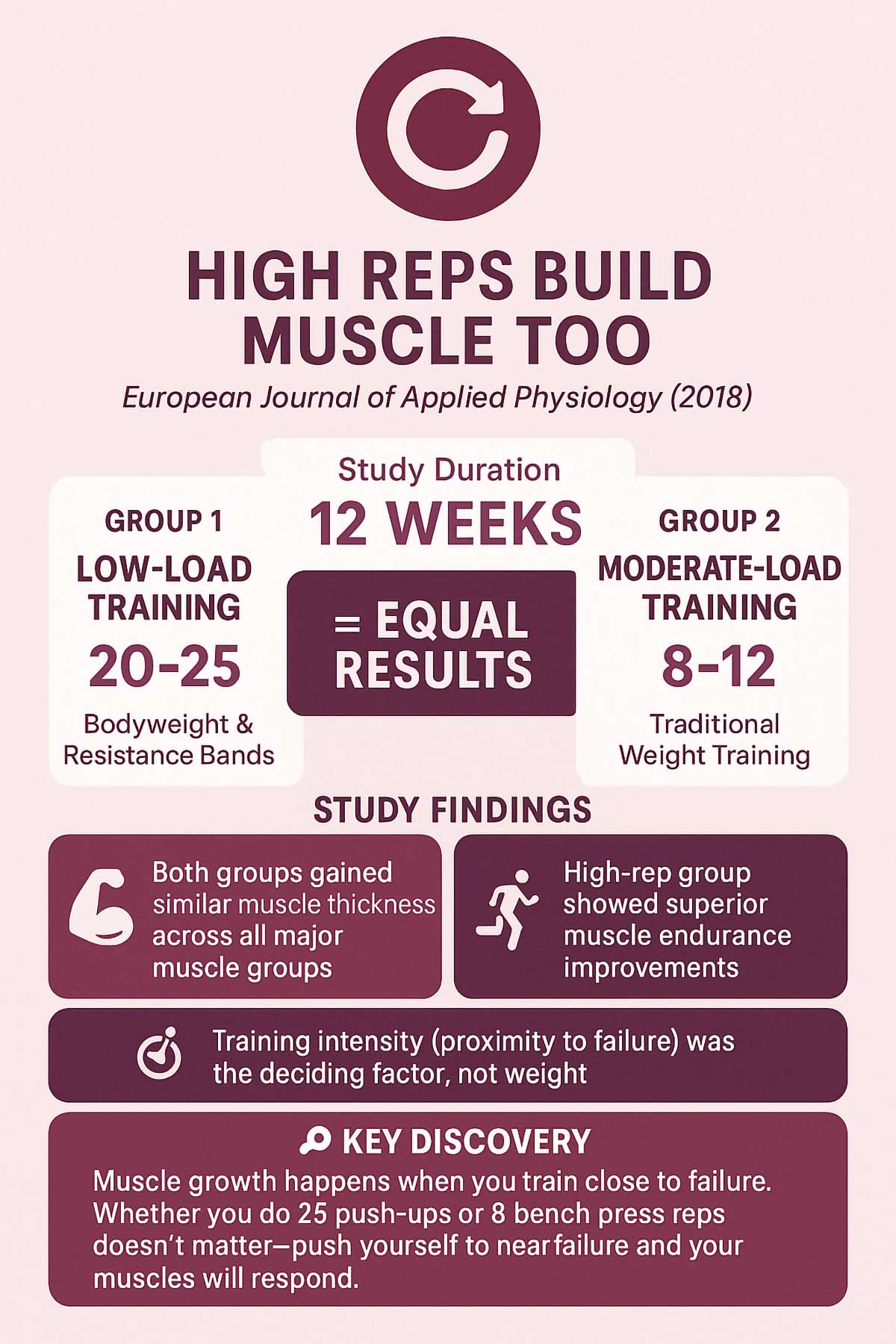
Study 3: Calisthenics work for middle-aged adults
Source: Frontiers in Physiology (2022)
What they did: Middle-aged adults (average age 48) did calisthenics training or machine-based training for 10 weeks, three times per week.
Key findings:
- Both groups showed comparable improvements in muscle endurance and tone
- Lean mass increased in both groups
- The calisthenics group showed better improvements in functional movement
- No significant injuries in the bodyweight group; 3 minor injuries in the machine group
What it means for you: Bodyweight training is particularly well-suited for adults over 40. It builds muscle while improving real-world movement and carrying lower injury risk.
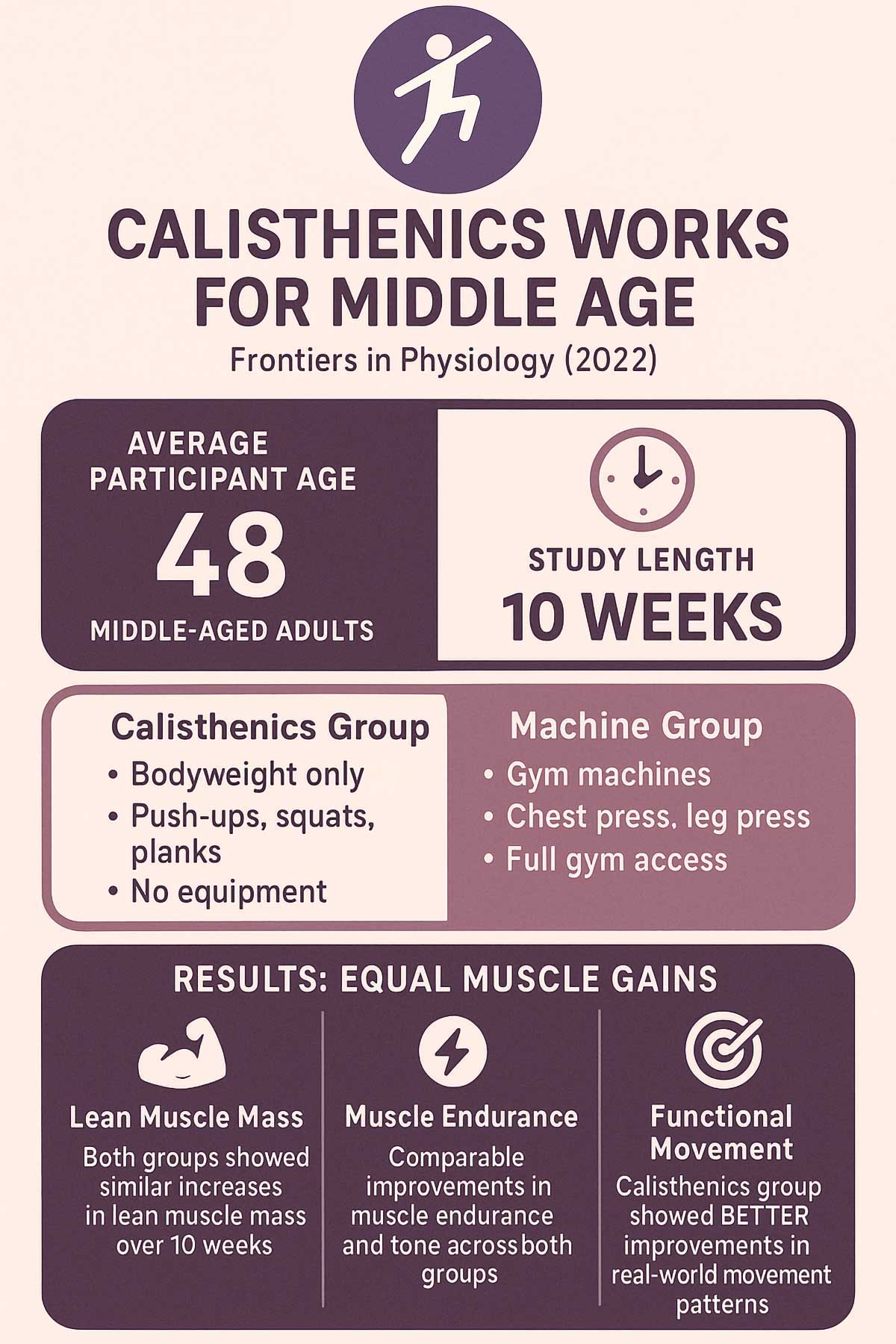
Study 4: Home training preserves muscle after 40
Source: Aging Clinical and Experimental Research (2020)
What they did: Followed adults over 40 doing home-based progressive strength training without equipment for 16 weeks.
Key findings:
- Participants maintained muscle mass even while in a caloric deficit
- Body composition improved significantly
- Functional strength increased across all measures
- Adherence was high (people stuck with the program)
What it means for you: Home-based bodyweight training works. You don’t need to go to a gym. The program you’re reading right now has solid science behind it.
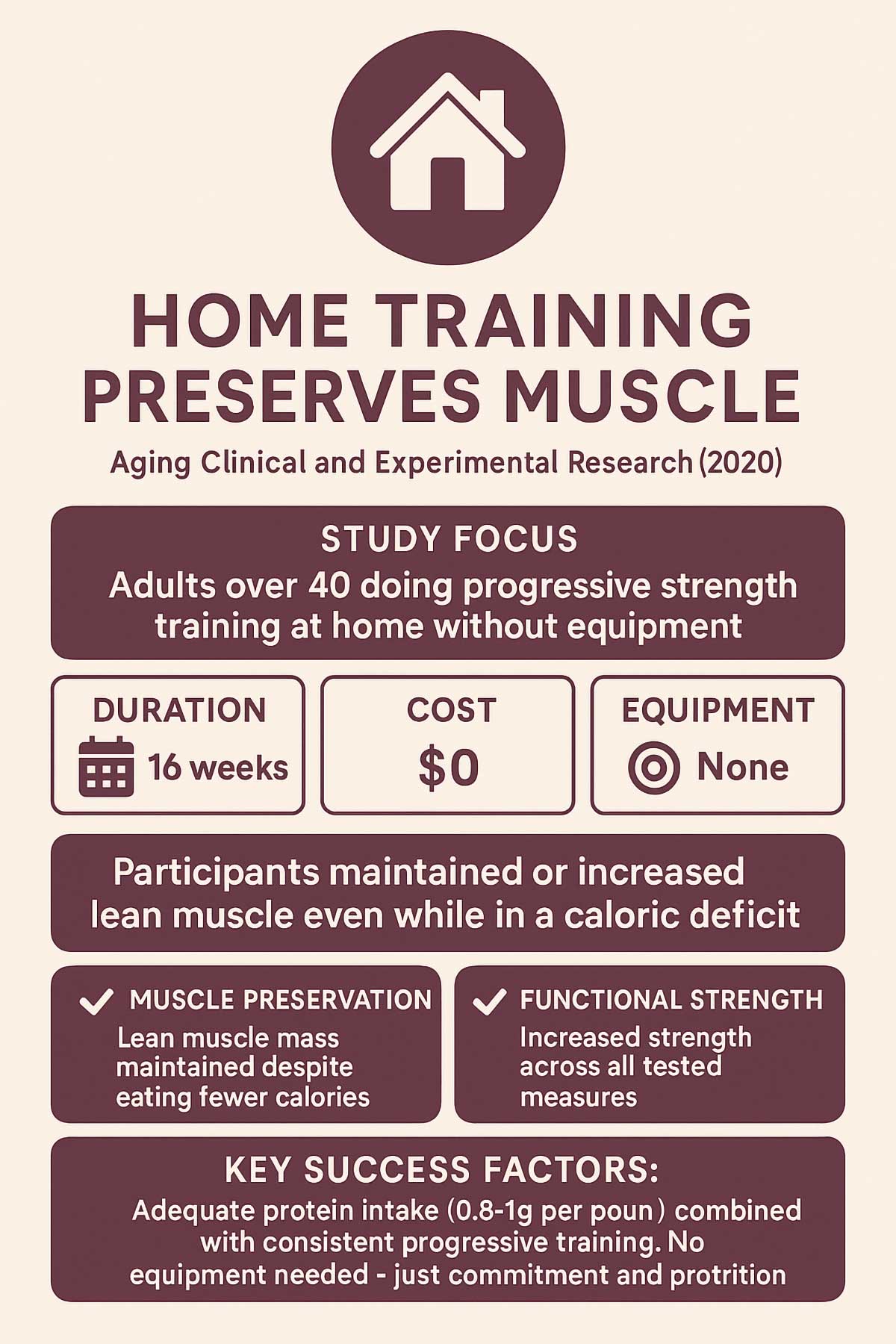
Conclusion
You now have everything you need to build muscle without a gym. Seven exercises. Three days per week. Progressive overload that keeps you improving. Nutrition guidance to fuel your growth. Recovery strategies to maximize results.
This isn’t theory. It’s backed by research showing bodyweight training builds just as much muscle as traditional weightlifting when done correctly.
You don’t need to be young to build muscle. You don’t need expensive equipment. You just need a plan and the commitment to follow it.
Start today. Right now. Pick your workout time and mark it on your calendar for the next 12 weeks. Treat these sessions like important appointments you can’t miss.
Test your current levels with each exercise. See how many reps you can do with good form. Write those numbers down in a progress tracker. That’s your baseline.
Do your first warm-up. Complete your first Workout A. Record your numbers. You’ve started.
Three months from now, you’ll look back and be amazed at how far you’ve come. But only if you start. Only if you stay consistent. Only if you trust the process even when progress feels slow.
Your body is capable of building muscle right now. Today. At your age. With zero equipment. This might take 4-8 weeks. That’s normal. You’re building strength progressively.
FAQs
Can I do this if I haven’t exercised in years?
Yes. Start with the beginner progressions for each exercise. If even those are too hard, modify further:
– Push-ups against a wall instead of a counter
– Hold a squat position for 10 seconds instead of doing reps
– Do knee planks for 15 seconds instead of full planks
The program meets you where you are. Progress at your own pace. Some people need 8 weeks to work up to the full program. That’s fine.
What if I can’t do a single push-up?
Start with wall push-ups. Stand facing a wall, place your hands on it at chest height, and push yourself away. Do 3 sets of 10-15 reps.
After a week, move your hands lower on the wall. Keep progressing until you’re at counter height. Then move to a table. Then a chair. Then the floor.
This might take 4-8 weeks. That’s normal. You’re building strength progressively.
Can I add cardio to this program?
Yes, but do it smart. Cardio can help with fat loss and heart health. But too much interferes with recovery and muscle building.
Safe cardio additions:
– 20-30 minute walks on rest days (doesn’t interfere at all)
– 2-3 sessions of low-intensity cardio per week (easy bike ride, swimming)
– One sprint or interval session per week (do this on a training day, after your workout)
Cardio that interferes with gains:
– Daily intense running
– Hour-long cardio sessions multiple times per week
– Training for a marathon while trying to build muscle
Listen to your body. If you’re adding cardio and your strength stops improving, cut back.
How long should workouts actually take?
– Warm-up: 5 minutes
– Workout A or B: 25-35 minutes
– Cool-down and stretching: 5-10 minutes (optional but helpful)
Total: 35-50 minutes per session. Three times per week is 105-150 minutes total training time.
If your workouts are taking longer, you’re either resting too long between sets or getting distracted. Set a timer for rest periods.
What about supplements? Do I need them?
No. You can build muscle with food alone. But some supplements can help if your diet isn’t perfect.
Worth considering:
– Protein powder: Convenient way to hit protein targets. Not necessary if you eat enough whole food protein
– Creatine monohydrate: 5g daily can help with strength and recovery. Well-researched and safe
– Vitamin D: Many people over 40 are deficient. Get tested and supplement if needed
Don’t waste money on:
– Testosterone boosters (they don’t work)
– BCAAs (unnecessary if you eat enough protein)
– Fat burners (ineffective and sometimes dangerous)
– Pre-workout formulas (mostly caffeine, which you can get from coffee)
Focus your money on high-quality food. That’s where results come from.
Can I train more than 3 days per week?
You could, but you probably shouldn’t. Three days per week is optimal for muscle growth with full recovery.
Research shows that muscle protein synthesis (the process that builds muscle) stays elevated for 36-48 hours after a workout. Training again before this window closes doesn’t add much benefit. It just adds fatigue.
If you want to do more, add light cardio or flexibility work on rest days. Don’t add more strength training.
The exception: After 6-12 months, when you’ve maxed out beginner gains, you might benefit from a 4-day split. But that’s not where you are now.
What if I miss a workout?
Life happens. Missing one workout won’t ruin your progress. Just continue with your next scheduled session.
Don’t try to “make up” missed workouts by doing two in one day or reducing rest days. That leads to poor recovery and worse results.
If you miss a whole week due to illness or travel, just start again with your next scheduled workout. You might need to reduce intensity slightly for the first session back, but you’ll bounce back quickly.
Consistency over 12 weeks matters more than perfection every single week.


